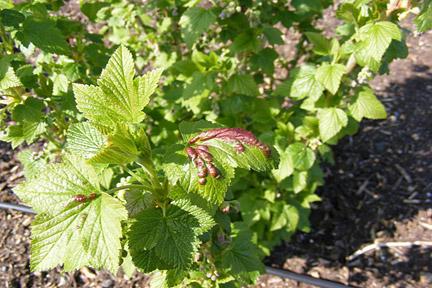Any change in the shape and color of currant leaves, the appearance of spots on them should alert even an inexperienced gardener. After all, this indicates some kind of disease, and the sooner the disease is detected and appropriate measures are taken, the more chances there are to preserve both the crop and the shrub itself.
So,
red spots on currant leaves, as a rule, indicate a fungal disease. By their size, shape and nature of distribution, you can understand what exactly the plant is infected with. If in the spring you noticed red tubercles on the branches, and by the summer the leaves began to turn brown and dry, then the bush is infected with tuberculosis. This disease spreads from one shoot to another, calmly tolerates winter cold. Therefore, you can get rid of it if you remove and burn all infected branches and leaves. To prevent its development in early spring, it is advisable to spray all the shoots with copper sulfate.
If you saw red spots on the currant leaves without distinct edges, then, most likely, the plant is damaged by ascochitosis. In the beginning, the center of the brown spot brightens, cracks, and the dead part of the leaf simply falls out. The fungus that causes this disease easily tolerates winter in fallen leaves. You can prevent infection if you spray with copper sulfate in early spring . But remember, the procedure must be repeated twice more: immediately after flowering and after harvesting. All fallen leaves must be collected and burned, and dig the soil under the bush.
But ascochitosis on
blackcurrant can occur a little differently. Only in the second half of summer can whitish or red spots appear on the leaves of currant, unevenly scattered across all the plates. They are not large, their middle almost does not fall out, and closer to autumn fruiting bodies form in the affected areas, in which the mushroom will winter.
Also, red spots on the leaves of currants may indicate its infection with columnar rust. The disease manifests itself in the middle of summer: the yellow spots that appear turn brown quickly enough, orange pads with spores form on the underside of the leaf blade. If the disease spreads quickly, then the leaves dry and fall prematurely.

Small, round or angular red spots on the leaves of currant are a clear sign of septoria. Over time, they brighten, but their border remains brown. The disease affects not only the shoots, but also the berries. Because of it, the leaves of the plant massively dry and fall, and the yield is significantly reduced. You can prevent infection by spraying shrubs in early spring with copper sulfate. But if this was not done on time, and the currant became infected with septoria, then the soil under the bushes must be dug up, and the fallen leaves burnt. The same methods should be used if the currant is infected with cercosporosis. It is characterized by the formation of brown spots with a dark center and bright edges, which increase in size, merging into one.
If you find any of the diseases, then you must take all necessary measures as soon as possible. At the same time, know that, despite all the beneficial substances contained in them, it is better not to use infected currant leaves. Their properties, of course, are preserved, but you will also eat mushrooms with which the bush was infected.